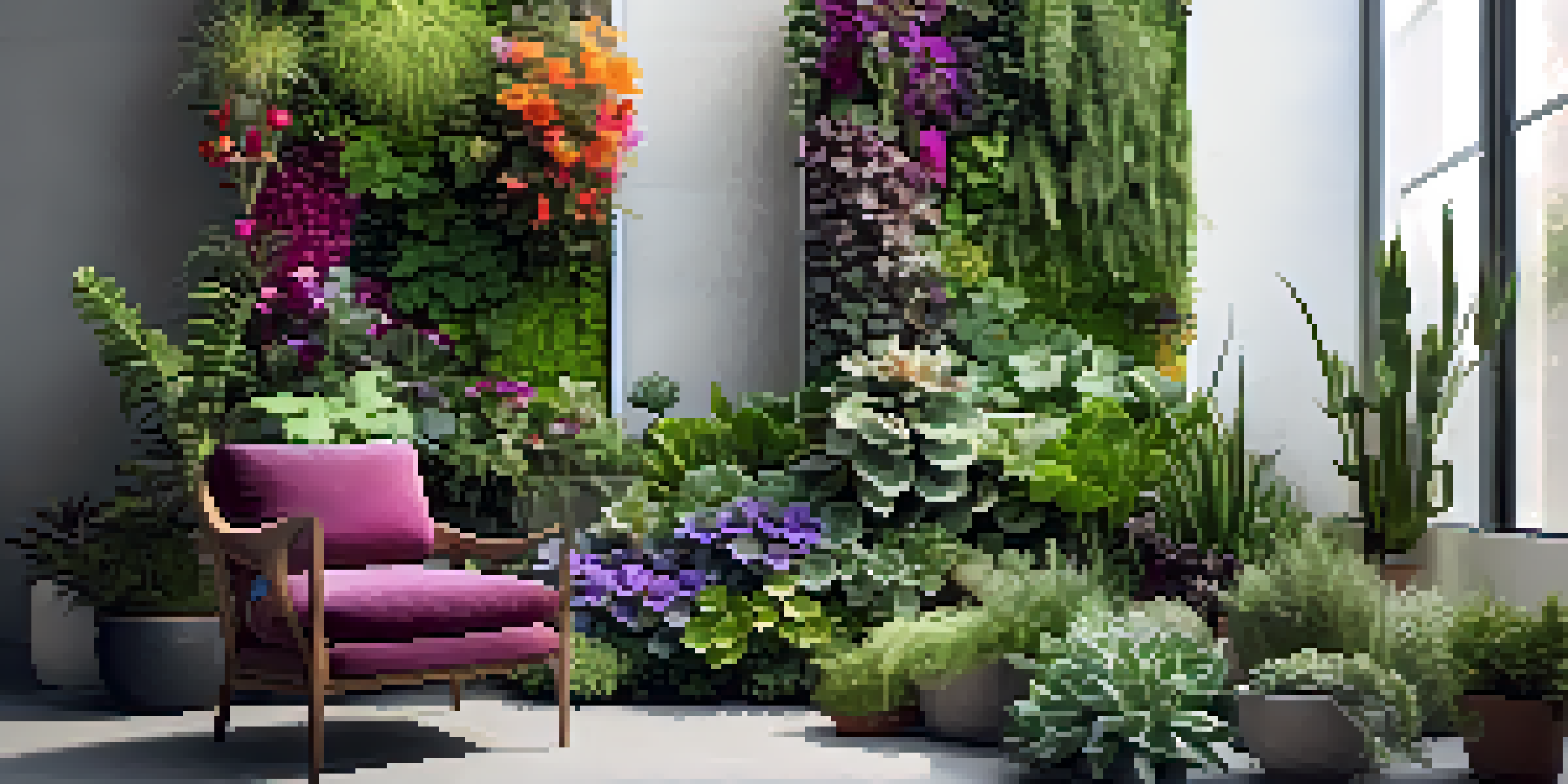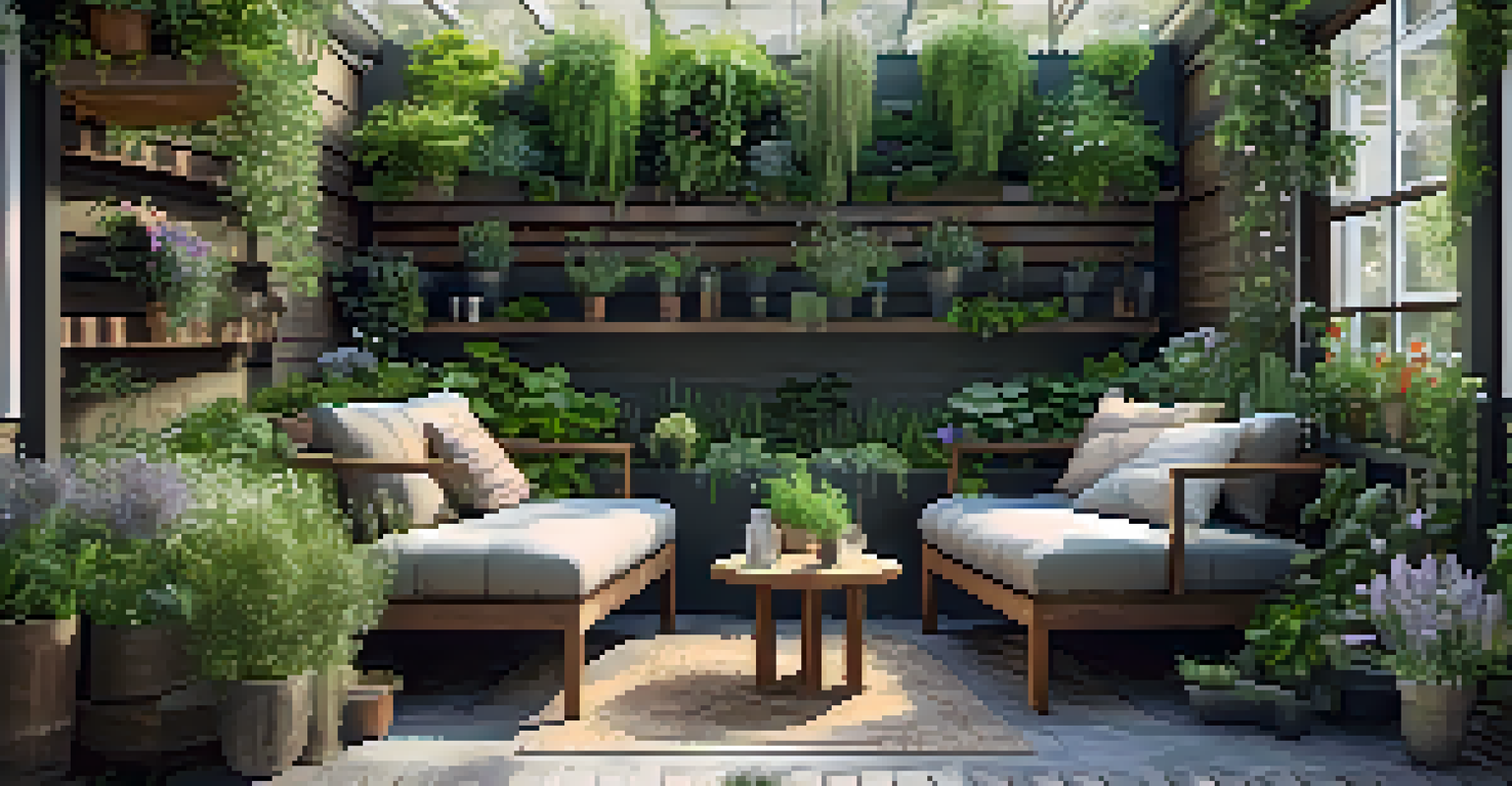Using Vertical Gardens to Maximize Small Outdoor Areas

Understanding Vertical Gardens and Their Benefits
Vertical gardens, also known as living walls, are a creative way to bring greenery into limited spaces. These structures allow you to grow plants upwards instead of spreading them out, making them ideal for small outdoor areas. Not only do they enhance the aesthetic appeal of your space, but they also improve air quality and provide a habitat for beneficial insects.
The best time to plant a tree was twenty years ago. The second best time is now.
Additionally, vertical gardens can help regulate temperature, which is especially beneficial during hot summer months. Imagine stepping out into a cozy, cooler area surrounded by lush, vibrant plants. It’s like having your own personal oasis right outside your door.
Moreover, these gardens can be customized to fit your personal style and the specific conditions of your space. Whether you prefer flowers, herbs, or succulents, there’s a vertical garden design that can meet your needs while maximizing your available area.
Choosing the Right Location for Your Vertical Garden
The first step in creating a vertical garden is selecting the right location. Look for a spot that receives adequate sunlight, as most plants thrive in bright light. However, some plants can tolerate partial shade, so it’s essential to consider your plant choices based on the sun exposure in your area.

Also, consider how accessible the location is for maintenance. You’ll want to ensure you can easily water and prune your plants without hassle. A reachable location will encourage you to take care of your garden, ensuring its success.
Vertical Gardens Enhance Small Spaces
These living walls allow you to grow plants upwards, maximizing limited outdoor areas while improving aesthetics and air quality.
Lastly, think about how the positioning affects your outdoor space. A well-placed vertical garden can serve as a natural privacy screen or a striking focal point, enhancing the overall ambiance of your small outdoor area.
Selecting Plants for Your Vertical Garden
When it comes to choosing plants for your vertical garden, consider a mix of textures and colors to create visual interest. Herbs like basil and mint not only smell delightful but can also be used in your cooking. Meanwhile, flowering plants such as petunias or geraniums can add vibrant pops of color.
Gardening is the purest of human pleasures.
Remember to select plants that are suitable for your climate and the specific conditions of your garden. For example, if you live in a particularly dry area, succulents and drought-resistant plants could be a great choice. This ensures that your garden thrives without demanding too much water.
It's also a good idea to incorporate trailing plants that can cascade down the sides of your vertical structure, adding depth and dimension. This layering effect creates a lush, full look, even in a compact space, making your garden truly stand out.
Designing Your Vertical Garden Layout
Once you've chosen your plants, it’s time to think about the layout of your vertical garden. Consider using a grid or staggered design to create visual balance. This way, taller plants can be anchored at the back, while shorter plants can fill in the front, giving depth to your arrangement.
You might also want to incorporate different levels to create a dynamic and engaging look. Using shelves, pockets, or hanging planters can add interest and make the most of your vertical space. This creative approach ensures each plant gets the sunlight it needs while also enhancing the overall design.
Choosing the Right Plants Matters
Selecting a mix of suitable plants based on your climate and garden conditions ensures a thriving, visually appealing vertical garden.
Don’t forget about the color scheme! Selecting plants with complementary colors can make your vertical garden pop, creating a stunning visual effect. A little planning will go a long way in ensuring your garden is both functional and aesthetically pleasing.
Watering and Maintenance Tips for Vertical Gardens
Maintaining a vertical garden might seem daunting, but it can be quite manageable with the right approach. Regular watering is crucial, especially in the hotter months when plants may dry out quicker. Consider using a drip irrigation system to efficiently deliver moisture directly to the roots.
Additionally, keep an eye on the plants for any signs of pests or disease. Early detection can save your garden from significant damage. A quick inspection every week can help you stay ahead of potential issues, keeping your vertical oasis thriving.
Pruning is also an essential part of maintaining your vertical garden. Regularly trimming back overgrown plants encourages healthy growth and prevents overcrowding. This simple task not only keeps your garden looking tidy but also allows each plant to receive the light and nutrients it needs to flourish.
Incorporating Vertical Gardens into Your Outdoor Decor
Vertical gardens can seamlessly blend into your existing outdoor decor, enhancing the overall aesthetic of your space. Consider placing your vertical garden against a plain wall or fence to create a striking contrast. This can turn an ordinary area into a stunning visual experience.
You can also complement your vertical garden with outdoor furniture or decor that reflects your style. For example, adding a cozy seating area nearby can create a tranquil retreat where you can enjoy the beauty of your garden. This encourages outdoor living and makes your small space feel larger and more inviting.
Vertical Gardens Benefit the Environment
They help reduce urban heat, improve air quality, and provide habitats for wildlife, making them a sustainable choice for outdoor decor.
Don’t be afraid to get creative! Use decorative pots, trellises, or even recycled materials to add unique elements to your design. These personal touches will make your vertical garden truly yours and a source of pride for years to come.
The Environmental Benefits of Vertical Gardens
Beyond their beauty, vertical gardens offer significant environmental benefits. They can help reduce urban heat and improve air quality by filtering pollutants and producing oxygen. This is particularly important in densely populated areas where greenery is often scarce.
Moreover, vertical gardens can provide insulation for buildings, lowering energy costs by keeping spaces cooler in the summer and warmer in the winter. This not only benefits the environment but also your wallet, making vertical gardens an eco-friendly investment.

Lastly, these gardens can support wildlife by providing habitats for various insects and birds. By creating a small ecosystem right in your outdoor space, you contribute to biodiversity and promote a healthier environment overall.